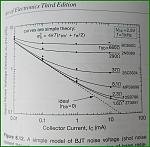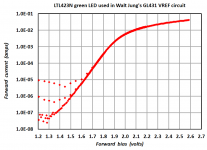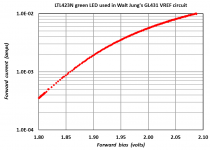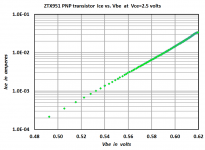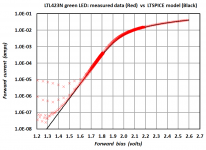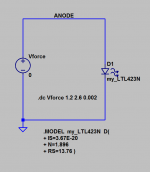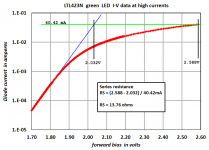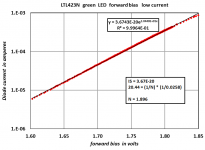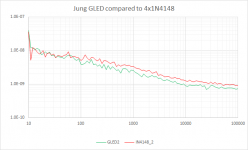A hearty thank you, Rax!
Hi Mark,
You're very welcome and I am very happy that you seem to have found the book as interesting as I have. Definitely a must have and a must read!...
Radu.
Art of Electronics book, 3rd edition, Table 8.1a.Yes, the BC560 is much higher noise than the ZTX951. See AoE, 3rd edition, Table 8.1a. Per H/H, rbb for a BC550C is 170ohm, while ZTX851 is at 1.67ohms. The PNP counterparts are typically lower in noise. The ZTX851/951 pair seems to be the best there is right now (still in production / conventional packaging).
This picture can be seen in mpp thread http://www.diyaudio.com/forums/analogue-source/154210-mpp-1062.html#post4606092 .
It can be magnified there.
Attachments
Last edited:
I bought 100 pieces each of '851 and '951 from Digikey; they were delivered this afternoon. Thanks again Radu.
Mark,I bought 100 pieces each of '851 and '951 from Digikey; they were delivered this afternoon. Thanks again Radu.
I have to pass along the thanks to Walt - he pointed out to me the parts Horowitz and Hill researched in the third edition (and the book for that matter).
These conventional, legged parts... They're on their way out. Stock now while you still can.
Radu.
If voltage is not important, use led alone can get lower noise than with TR ?
The elegant simplicity of this circuit - adding one Vbe (appropriately chosen, both by part selection and optimal bias, every part being thoughtfully tweaked, in typical Walt fashion) on top of a green LED to arrive at this reference standard voltage - shouldn't detract any from expectations of extremely low noise. In fact, I think that Walt is likely being conservative in his noise estimate. And from my builds, it behaves very stably under a varied set of conditions.
To possibly answer your concern there, per volt - which is the relevant metric here, I believe - this circuit likely exceeds the noise performance of one or more (series) LEDs.
I just want to report that Walt's GLED431 is working great on my OP amp based regulator. The detail and the depth of the song is improved. I also replaced my OP amp with LT6200 (as Walt mentioned on his blog) with very positive effect. Before that, it was LME49710 for the 5V rail (Not much choice here). The LT6200 beats it no doubt. I checked with my scope and it's pretty stable on my regulator. BTW, my previous VREF was Sipex AS431 which has very low noise internal band-gap reference compared to others. (below 50nv/root(HZ)) If Walt was right, GLED431's noise is only 1/50 of it! Truly remarkable!
Last edited:
I bought 100 pieces each of '851 and '951 from Digikey; they were delivered this afternoon. Thanks again Radu.
The 10 and 100 per pieces price is better at Mouser. Just FYI. No biggie, just thought I would let folks know since I did the comparison.
The ZTX851/951 pair seems to be the best there is right now (still in production / conventional packaging).
I got them this week, too, from Mouser. I want them in SOT-89.
Also got some IF3602. Now what is the true pinout of these?!!
There is one in old data sheets, but it does not say top or bottom view.
Apparently they could not make up their mind and elegantly moved the
decision to the customer by deleting the mechanical drawing altogether.
🙁
regards, Gerhard
I took some data on the LED and on the PNP bipolar transistor, used in Walt's GLED431 circuit. Maybe it will help someone build a couple of spice models, or accurately represent the circuit in a spreadsheet? In any case, this is the exact LED part number from Lite-On that Walt recommends, and the exact PNP from Zetex/DI that Walt calls for.
The jaggy dots on the left side of the diode plot, are nothing more than my curve tracer doing a lousy job of auto-ranging. Feel free to delete those outliers before you throw the data into a function fitting subroutine!
Raw I-V data is in Excel format, compressed into a .zip archive so the DIYA forum software will accept it.
The jaggy dots on the left side of the diode plot, are nothing more than my curve tracer doing a lousy job of auto-ranging. Feel free to delete those outliers before you throw the data into a function fitting subroutine!
Raw I-V data is in Excel format, compressed into a .zip archive so the DIYA forum software will accept it.
Attachments
Thanks for the graph. I choose 5ma for the circuit, but the drift is a problem. LED is extremely sensitive to temperature. Make sure your chassis has good ventilation or this little circuit will drop to 2.4V or 2.3V. This is not good for a regulator as the output voltage varies a lot.
Gosh, that's a big disappointment. I clicked on the link from jackinnj in post #1 to read what Walt had to say about temperature dependence, but his blog has disappeared. Did anyone archive the GLED431 article? I'll send you two KitKat bars if you post it here!... the drift is a problem. LED is extremely sensitive to temperature. Make sure your chassis has good ventilation or this little circuit will drop to 2.4V or 2.3V. This is not good for a regulator as the output voltage varies a lot.
Blue or white LEDs ,which have higher Vf, often give better Vnoise/Vf. Try them if you do not bother TL431 compatibility.
Blue or white LEDs ,which have higher Vf, often give better Vnoise/Vf. Try them if you do not bother TL431 compatibility.
I remember someone did noise measurements on various LEDs. Among them, White/Blue LEDs are the worst where Red/Green LEDs are the best. White/Blue are several times noisier than others.
Last edited:
I remember someone did noise measurements on various LEDs. Among them, White/Blue LEDs are the worst where Red/Green LEDs are the best. White/Blue are several times noisier than others.
This thread: http://www.diyaudio.com/forums/parts/35821-some-noise-measurements-leds-zener-diodes.html
Thanks! PM me your address where I can mail the Kit Kat bars.the archives are having all those articles
http://www.waltjung.org/PDFs/Walts_Blog_2014_GLED431.pdf
Thanks! PM me your address where I can mail the Kit Kat bars.
Thanks
done without expecting Kit kat bars- would like you to give it to the neighbour;s kids
kannan
Fitting SPICE model parameters of a diode
I grabbed those Excel tables of data and fit an LTSPICE model to the Current vs Voltage measurements from the green diode. My step-by-step process, and its results, are shown in the images below. In my opinion the fit is pretty good.
_
I grabbed those Excel tables of data and fit an LTSPICE model to the Current vs Voltage measurements from the green diode. My step-by-step process, and its results, are shown in the images below. In my opinion the fit is pretty good.
_
Attachments
Here's some noise data -- this is cleaned up from that which I published on Sams 60dB Groner's Low noise measurement amp from Linear Audio vol 3 - spare boards?
I tack soldered the LN amplifier inputs to the Voltage References, reduced the leads from the batteries to about 5cm and RMS'd out the noise contribution from the LNA (stacked SSM2019's). I used a green LED HLMP-30 and CCS diode of 4.7mA for each:
I tack soldered the LN amplifier inputs to the Voltage References, reduced the leads from the batteries to about 5cm and RMS'd out the noise contribution from the LNA (stacked SSM2019's). I used a green LED HLMP-30 and CCS diode of 4.7mA for each:
Attachments
and CCS diode of 4.7mA for each:
Oh my, oh my-oh -- I just looked at the price of those CCS diodes -- 1N5314 -- thankfully I still have 3 left -- price of a good bottle of Cabernet each!
will have to use the DN2540N3 which are TO-92.
- Home
- Amplifiers
- Power Supplies
- Mr. Jung's ultra-low noise VREF - the GLED431
